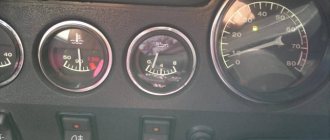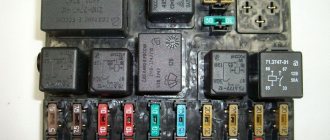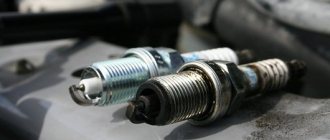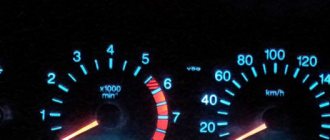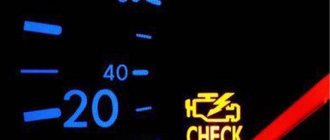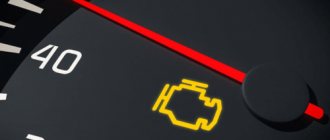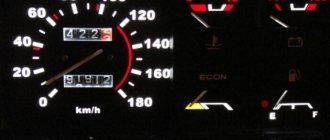The check light on a Hyundai Solaris is on - this means that some of the car’s systems are not working correctly. There can be many reasons. Many car owners try to solve the problem with their own hands. Those who do not understand this matter turn to a car repair shop. Experienced mechanics quickly find the error and fix it.
However, they charge a lot of money to solve the problem. Experienced car owners say that if this error occurs, you can handle it yourself. Let's look at the common reasons when the Hyundai Solaris check light comes on.
Check on Solaris: blinking or on, reasons, what to do
The Solaris engine check light is on when the system begins to work incorrectly. Possible causes include insufficient tightening of the gas tank cap or engine failure. You need to check different parts of the working system, then promptly take action. If you can’t resolve the issue on your own, contact a service station. The risks of incorrectly lighting up checks will be reduced significantly if scheduled maintenance is carried out in a timely manner. You cannot ignore the signals, otherwise the problem will only get worse over time.
Common breakdowns and causes of their occurrence
The main reason for the appearance of various kinds of negative consequences is the rather poor handling of the Hyundai Solaris, due to which it is necessary to regularly undergo high-quality maintenance. As a result, the car is poorly controlled at speeds of 80 km/h, which is especially dangerous for novice drivers, whose mistakes can lead to an accident, long-term treatment, and large financial losses associated with it and the restoration of the car. Considering this fact, it would be appropriate to carry out a comprehensive repair of the suspension with the replacement of shock absorbers and springs.
This is due to the fact that the installation of stiffer shock absorption systems contributes to better handling, but this will mean sacrificing a comfortable ride on a dirt road. It is important to periodically inspect the front stabilizer mounts, the failure of which results in the car wobbling at high speeds.
Less significant, but still unpleasant problems that car owners may encounter are:
- Rapid wear of bearings, which is facilitated by old grease and constant exposure to dirt and dust.
- Engine system breakdowns caused by poor quality gasoline. As a result, you should not be surprised by the inability to start the car the first time, its uneven operation when driving, or the fact that the car constantly stalls when stopping.
- Minor electrical problems such as spontaneous activation of the high beam when turning right, problems with the fuel pump.
- The need to periodically tighten the bumper mounting bolts, which are prone to constant loosening.
- Occasionally, annoying troubles arise associated with the onset of frost, which is the reluctance of the engine to start, as well as freezing of the alarm lock.
Timely diagnosis and subsequent decoding of errors will allow you to avoid the need for repairs and a long separation from your pet. In order to minimize the possibility of malfunctions, it would not be superfluous to replace some parts of the car, increase ground clearance and eliminate the problem of insufficient lighting, which will allow you to get even more pleasure from driving this wonderful car.
Hyundai Solaris. The engine does not start - reasons, troubleshooting
Common reasons why a car engine does not start
The reasons can be both general and specific. Let's look at the most common problems.
First place, perhaps, can safely be given to problems with the battery. Very often the engine does not start as a result of the battery being discharged. It is not necessary that the charge be completely absent. In many cars, the starter refuses to turn if the battery produces less than 10 volts.
Taking into account this information, it becomes clear that you should not forget to recharge the battery on time. However, complete failure or problems with starting the engine are not always associated with a low battery charge level. Quite often, oxidized or poorly secured terminals are to blame.
From time to time you need to clean them with sandpaper to remove the deposit of oxide film, which is a poor conductor of electricity. The same applies to the contacts on the battery itself. After cleaning, it is recommended to lubricate the terminals with machine oil or lithol so that they do not oxidize. Better yet, replace the copper terminals and install brass ones.
In second place in terms of frequency is a very simple and harmless reason - lack of fuel. There are two options: it may not be in the tank, or it may not enter the engine. The driver's actions in this case are extremely simple. First, check the tank (the sensor may fail or show incorrect values).
Fuel may not enter the combustion chamber due to a clogged carburetor or injectors on injection engines. In addition, it happens that the fuel pump fails. The reasons for this can be different, but the most common one is overheating of the fuel pump.
Of course, we are talking about those cars in which the pump is installed under the hood (usually carburetor cars). It overheats especially often in the summer heat. Another option, although very rare, is that gasoline has lost its properties (evaporated, diluted with condensate, etc.).
Error code: EPC Volkswagen Polo Sedan: what to do if the EPC error comes on, the functional purpose of the system, methods for diagnosing and troubleshooting the problem yourself | Volkswagen New
Problems in the ignition system
No spark at the spark plugs or wet spark plugs. This is also a very common reason why the engine will not start. You can check the spark plugs yourself. To do this, you need to have a spark plug wrench in the trunk. Checking for a spark is also not difficult.
To do this, you need to unscrew the spark plug, put a contact wire on it and try to turn the ignition key at the moment when the spark plug itself is near the metal. A good spark should be fat and bright. If the spark is weak or absent at all, you should take a closer look at the spark plug contacts.
It happens that the spark plug is fine, but there is still no spark. Here you need to check the armored wires and even the ignition coil. By the way, the capacitor on the ignition coil may fail. It is advisable to have a spare one with you (it costs pennies).
There is no spark on the center wire. You can check this way: disconnect the central wire from the distributor cover and unscrew the tip. After this, you need to turn the key and keep the end of the wire near the metal. There must be a good spark. Problem with the ignition switch.
It happens that some terminal falls off in the lock itself. Especially on older cars. Naturally, you need to know where to put it again. In addition, fuses may blow. Therefore, it is always worth having a set of spare ones in your car. It is inexpensive, does not take up space, and a blown fuse can not only be the reason why, for example, turns do not work. It’s worse when the internal combustion engine does not start for this reason.
Other possible faults
Problems with the starter solenoid (traction) relay. The most common problem here is burnt nickels (can only be seen when the device is disassembled). In addition, contacts may become unsoldered from them. In this case, when you turn the ignition key, only a quiet click of the starter relay will be heard, and the retractor will be silent.
The starter has failed. If, when the car engine starts, a click is clearly heard when you turn the key, but the start does not occur, and the battery wires get hot or even smoke comes from them, then the starter needs to be replaced. The ignition is set incorrectly. This happens after engine repair. In this case, you should contact a specialist.
The distributor is filled with water or simply wet. This happens, for example, when driving through large, deep puddles. In this case, the spark will simply go away (break through) and not reach the spark plugs. The solution is simple: wipe the distributor and let it dry. The engine may not start because it is jammed.
Results
So, as follows from everything that is written above, answering the question of why the engine does not start is not so simple. All reasons can be divided into three main groups: - problems with fuel supply; -electrical problems; -problems with mechanics (that is, with the engine itself).
It is recommended not to forget to regularly carry out scheduled maintenance, additionally check the engine and attachments before a long trip, charge the battery in a timely manner and fill the gas tank with only high-quality fuel.
Despite the fact that the Hyundai Solaris car has typical faults, due to the large number of qualities they still remain very popular. Compared to other brothers in this class, servicing this model does not require huge financial expenses from the driver.
But there is one exception that nullifies all the praiseworthy stories about this car. This, of course, is the car’s suspension, the front is made of the Mac Pherson type, and the rear is a double wishbone. The manufacturer considered that such a solution could help improve ride comfort, as well as achieve other positive results.
Diagnosing errors on Hyundai Solaris
If the CHECK light comes on when you start the engine, then there is no need to worry. But if the check light is on when the engine has already started, then you need to find out the cause of the error.
The vehicle owner may need to diagnose and remove errors that occur on the Hyundai Solaris in various situations when there is no desire to do this work in a certified service center.
It is not difficult to do this work, the main thing is to know that you can delete errors related to the first level , that is, those that are not recorded in the ECU memory and do not significantly affect the operation of the car and its devices. Because only a special dealer device (scanner - approx.) can remove such errors, one of such errors includes the error of the car's airbags.
When do you delete errors yourself?
Among all the important problems with the Hyundai Solaris, some can reset themselves after one or another repair.
For example, error codes from 301 to 304 , indicating a missed spark in one of the cylinders (the last error digit refers specifically to the cylinder - approx.).
If the error indicates a misfire in the cylinder, the first thing to look at is the condition of the spark plug. In the photo the candle is the culprit of this error.
Accordingly, when these gaps are detected, the ECU will give a signal in the form of a burning “CHECK”, which cannot be removed either by erasing the code or by resetting the terminal from the battery.
This error can be completely removed only by replacing the non-working spark plug with a new one, after which the error will disappear by itself.
How to reset a check
If the Hyundai check light comes on, you can reset it yourself. The only question you should ask yourself before resetting is whether it is wise to do so. If you answer yes, then proceed to the next steps:
Similar article VAZ 11186 engine, do the valves bend on the 8 valve Grant
- Install the scanner in place of the car's diagnostic block.
- Go to a special menu and reset error codes.
If it doesn’t work, then try the next method. Reset the left terminal of the battery for 10 minutes. Then you get dressed and start the car. The check will no longer light up on the Hyundai Solaris.
If the check engine light continues to light, you should contact a car repair shop.
What does the icon on the Solaris dashboard mean?
Regardless of the year of manufacture, 2011, 2013 or 2022, the indication and appearance of the indicators are practically the same. Cars with a new body are equipped with standard instrumentation and all the bulbs, except for the ones added, will be identical. Globally, icons are divided into three types:
- index;
- warning;
- prohibiting movement.
The group breakdown looks like this.
- Notify the driver about the normal operation of standard systems.
- Warns the driver about problems that require intervention. This could be the activation of the TPMS system, the end of the fluid in the windshield washer reservoir, and others.
- When such icons flash, you must immediately stop the machine and fix the problem. Driving with a light on, such as check the engine or critical overheating of antifreeze, is strictly prohibited.
Checking the oil level and condition
The next most important reasons for the signal are considered to be overheating of the motor and a decrease in the level of lubricating fluid in the internal combustion engine. It is recommended to check the engine temperature. If there is no overheating, you need to check the volume and condition of the oil. After checking the level, it is necessary to add the missing amount of lubricant. Using a clean paper napkin, the quality and composition of the engine oil is checked according to the following criteria:
- Color.
- Consistency.
- Presence of mechanical inclusions.
- The smell of burning.
If everything is in order with the quality and quantity of oil, the engine starts to eliminate unusual sounds and noise when operating both at idle and under load.
If unusual noise effects of a running engine are detected against the background of a burning check, it is recommended to send the car to the nearest service company. Moving the car yourself is not recommended; delivery is carried out by towing or other convenient method. Further operation can lead to serious damage and costly repairs to the elements of the power unit.
The process of diagnosing and resetting errors without OBD-II
On the Hyundai Solaris, you can diagnose and remove errors, even without having any additional devices at hand.
Diagnostics (this method does not work)
The method described below is circulating all over the Internet. We checked on our editorial machine. He does not work. We do not remove the method, as some owners may think that it works.
Refutation on video:
- We turn on the ignition, but do not start the engine - count 3 seconds.
- Next, squeeze the gas to the end 5 times in a row, and after the fifth, sharply release the pedal.
We press the gas pedal as written in the algorithm.
- We wait 7 seconds, and again press the pedal fully once.
- After this, the indicator on the instrument panel should flash.
- Let's release the pedal and look at the instrument panel and the trouble code.
- To exit the menu, turn off the ignition.
Topic: Tachometer signal drops when connecting Zont to Solaris 2012 GV
Theme Options
- print version
- Subscribe to this topic...
Tachometer signal drops when connecting Zont to Solaris 2012
Hello! Solaris 2012. Zont 710. Problems with determining engine operation. I take the tachometer signal from the connector in the instrument cluster. With the combination completely disconnected and input 4 of the Umbrella connected to the connector, autostart in the test mode with the setup utility works exceptionally well. When connecting the connectors to the combination, the signal drops almost to logical zero. I looked at it with an oscilloscope. Autostart, accordingly, stops working. I tried decoupling with capacitors - it didn't help. I tried to amplify the signal with a transistor cascade, the signal increased, but in general, this unit does not work correctly with the Umbrella. Or an umbrella with a knot. Finally turned it off. Now autostart works with detection via the on-board network. The threshold was set to 13.7 Does anyone have any proven solutions to this problem? Would you like to share?
Re: Tachometer signal drops when connecting Zont to Solaris 2012 GV
Gregor
, and from which connector and from which specific wire (pin number, color?) do you take the tacho signal. On these machines, the instrument panel receives information about engine speed via the CAN bus.
Re: Tachometer signal drops when connecting Zont to Solaris 2012 GV
I support the previous commentator. On Solaris and Rio, connections were made through the generator in the dashboard or through the nozzle under the hood, depending on the owner’s wishes. I didn’t even bother to find the tach signal in the dashboard, since initially the information was that it was in all the dashboards of Solaris and Rio. It may be available in some similar configurations, but I haven’t come across it yet. Are you sure it's the tacho wire?
Re: Tachometer signal drops when connecting Zont to Solaris 2012 GV
The leftmost connector, MA1, it seems. I won’t tell you the pinout now. Like green. I looked at it with an oscilloscope, clearly, when the engine starts, there are pulses. When preparing for installation, I immediately had information, including from the developers of the Umbrella, that the CAN tire in the 2012 Solaris was castrated, so I didn’t even bother with it. The latest information on my question now - I just launched everything. As a result, autostart is based on the generator. The signal was received in the 4th (20 pin connector, 15 leg). I also mistook it for a tachometer at first, although the documentation says it’s a generator. There was no oscilloscope, I used an indicator. When the engine starts, there are pulses. Well, that means a tachometer. Moreover, Umbrella normally identified it as a tachometer, calibrated it at 11 Hz, even. My mistake was that the test had to be done with the device connected. I mistook some kind of generator pulsation for tachopulses. With the device connected, the umbrella with this output, like a tachometer, refused to work. Reconfigured as a generator - everything is in order. I installed only five Umbrellas in the same way and did not connect the device anywhere for checks and everything was without problems. Here, apparently, there is a feature of Solaris, which I will now take into account. Thank you!
Diagnosing errors on Hyundai Solaris
If the CHECK light comes on when you start the engine, then there is no need to worry. But if the check light is on when the engine has already started, then you need to find out the cause of the error.
The vehicle owner may need to diagnose and remove errors that occur on the Hyundai Solaris in various situations when there is no desire to do this work in a certified service center.
It is not difficult to do this work, the main thing is to know that you can delete errors related to the first level , that is, those that are not recorded in the ECU memory and do not significantly affect the operation of the car and its devices. Because only a special dealer device (scanner - approx.) can remove such errors, one of such errors includes the error of the car's airbags.
When do you delete errors yourself?
Among all the important problems with the Hyundai Solaris, some can reset themselves after one or another repair.
For example, error codes from 301 to 304 , indicating a missed spark in one of the cylinders (the last error digit refers specifically to the cylinder - approx.).
A few words about how the battery-generator tandem works
In order to prevent the above described, a small relay-regulator is installed in the rotor excitation circuit, the task of which is to reduce the current to the optimal level, regardless of the engine speed. As a result, the voltage is maintained at the required level. The battery light comes on when there is no charging from the generator.
- Faulty relay-regulator, diode bridge;
- Poor tension of the generator belt, critical wear or belt slippage. Wear (play) of the generator bearing;
- Blown fuse or poor contact;
- Poor contact at the battery terminals, at the generator terminal or at the ground wire;
- Open circuit of the generator excitation circuit, serious wear of the generator brushes or brush holders;
- Wearing out the ignition switch is an option, but in this case several lights will light up at once.
If the battery light is on while the engine is running, do not turn it off, open the hood and check the voltage at the battery terminals. If charging is supplied to the multimeter, the voltage should be 13.5-14.3V. If there is no charging, the voltage will be much lower - approximately 12V.
- Two screwdrivers (flat and Phillips);
- “Control” (12V light bulb);
- Multimeter;
- Pliers, a knife and sandpaper to clean the contacts.
Treatment: We strip the high voltage terminals and wires, after which we measure the voltage again. If this does not lead to anything, check the voltage at the “30” terminal of the generator. Connect one electrode of the multimeter to the generator terminal, the second to ground.
- In addition, the cause of the above situation may be a breakdown of one of the diodes or a break in the stator winding. Do the following - turn off the ignition, then check the diodes with a multimeter; if a breakdown is detected, replace them.
- It would be a good idea to check the generator brushes. To do this, simply remove the brushes and check their length, if the length is less than five mm. I recommend replacing the generator brushes.
- Situation four - after turning the key there is no charging, but all devices are functioning, the battery light does not light up.
- The reason may also be poor contact in the connector. It is necessary to clean everything properly and check the result; if it is not there, it is very possible that the lamp has burned out. If the problem is not in the light bulb (it burns dimly or intermittently), then other indicators will also light dimly or intermittently; if this only happens with the battery indicator, then perhaps the reason is in the light bulb itself.
Error code: BMW error codes | Car service, Diagnostics, Chip tuning
After all the above checks, check the relay regulator, apply voltage to its contacts. Check the voltage on the brushes, if it is 12V, the relay is working properly. Otherwise, replace the relay regulator.
Check the fuel filler cap
Many drivers, in most cases, when the “check engine” indication appears, will think about serious problems in the car’s engine, but will not even think to check the tightness of the fuel system, which may be compromised due to a defect or an insufficiently tightened fuel tank cap. This is a very common reason for the appearance of the “Check” engine icon.
Reason for the error:
Leakage of the fuel system due to the passage of air through the fuel tank filler cap will increase the vehicle's fuel consumption, to which the vehicle's diagnostic system will generate an engine error by turning on the "Check engine" indication on the vehicle's instrument panel.
What to do:
If, when the “Check” indication appears, your car has not lost power, and there are no audible signs of engine damage (engine knocking, humming, creaking, etc.), then first check the gas tank for leaks.
Your gas cap may be cracked or not tightened enough. If the cap was not tightened enough, then after tightening it all the way, continue driving the car for a while to see if the engine error disappears. To prevent a check engine light from appearing for this reason, check your fuel filler cap regularly. Remember that the cover must be replaced with a new one periodically!
Car exhaust catalyst
An automobile catalyst helps a car make engine exhaust gases more environmentally friendly. It converts carbon monoxide and other harmful substances into harmless compounds. If your exhaust catalyst has become unusable, you will notice it not only when the engine icon (check) appears, but also long before that, when the car’s power drops by half. For example, when you press the gas pedal, the car will not have good acceleration dynamics as before.
What can cause a car catalyst to fail:
If you regularly service your car in accordance with the car company's maintenance regulations, then the catalyst should not fail. The main reason for catalyst failure is untimely replacement of a faulty oxygen sensor, as well as non-regular replacement of spark plugs when their expiration date expires. When the oxygen sensor or spark plugs are faulty, the conversion of carbon monoxide in the catalyst into harmless chemical elements stops, which leads to overheating of the catalyst, which can therefore fail.
What to do:
If your catalyst has become unusable, then you cannot drive a car, since the engine will not work correctly, warning about this by an indication on the dashboard with an engine icon (check).
Also, your fuel consumption will be greatly increased, and there will be no engine thrust. Although replacing a catalyst is a very expensive repair, there is no escape from repairs. Although there is an alternative to replacing the catalyst with a flame arrester, this is not a 100 percent option. Unfortunately, if you are not an experienced auto mechanic, you will not be able to replace a faulty exhaust gas catalyst yourself. In any case, you will have to contact a car repair shop. Remember that timely replacement of oxygen sensors and spark plugs protects your catalyst from damage!
Replacing spark plugs and high-voltage wires
Spark plugs in a car are the main components for igniting the fuel mixture. If the spark plugs are faulty, the spark will not be supplied correctly to ignite the gasoline mixture. Faulty spark plugs often result in a lack of spark or an incorrect spark interval, which results in the engine not running properly. If the spark plugs do not work properly during acceleration, especially from a standstill, you may feel slight jolts.
What are the reasons for spark plug failure: Most spark plugs in cars produced before 1996 need to be changed every 25,000-30,000 kilometers. In newer cars, spark plugs last more than 150,000 km. However, these scheduled spark plug replacement intervals may be reduced by various factors related to fuel quality and driving style.
What needs to be done: If your spark plugs have not been changed for a long time, or you feel failures in the engine operation associated with ignition, then you must immediately replace them with new ones without delay. Do not try to save money by untimely replacement of spark plugs, since the cost of spark plugs is not very expensive, as well as the work of replacing them.
By replacing old spark plugs, you will improve engine performance and reduce your vehicle's fuel consumption. Changing spark plugs yourself is quite easy. Basically, they are easily accessible under the hood of the car. You need a regular spark plug wrench to remove the spark plugs from the engine.
It is also advisable to monitor the condition of high-voltage wires, since over time they can become unusable and allow electricity to pass through, which is transferred to the spark plugs, which will reduce the strength of the spark. Remember that regularly replacing spark plugs, in accordance with your car’s maintenance schedule, protects your exhaust catalyst from breakdowns and also improves engine performance!
This article was originally published in 2013 and updated with new information on 02/17/2020.
The battery charging light is on
Each of you has probably noticed a little red box on the instrument panel indicating the battery. We all know that it lights up when you turn the key in the ignition and goes out when the engine starts. Why is this happening? When you insert the key and turn it in the ignition, automatic diagnostics of almost all engine systems (ABS, ESP, Airbag, Check Engine, etc.) occurs; after a successful self-test, the indicators go out, which indicates the serviceability of one or another system. The same is with the battery, when it is ok, the indicator goes out, in case of problems with the battery, the battery lamp lights up.
Replace the oxygen sensor (lambda probe)
The oxygen sensor in your car is part of the exhaust system that monitors how much oxygen is not burned in the engine's combustion chamber. This sensor helps control the vehicle's fuel consumption. A malfunctioning oxygen sensor (lambda probe) means that the car computer is receiving incorrect data, which can significantly increase fuel consumption and reduce engine power. Most cars have 2 to 4 oxygen sensors. If you have a home car error scanner, then by connecting it to the car, you can easily find out which sensor needs to be replaced.
For what reason does the oxygen sensor in a car become unusable?
Over time, the sensor becomes covered with a layer of used engine oil (oil soot), which reduces the accuracy of reading sensor readings for regulating the gasoline mixture and distributing the optimum. A malfunction of the oxygen sensor in a car leads not only to, but also to an increased content of harmful CO2 substances in the exhaust.
What to do:
If you do not replace a faulty car oxygen sensor, this can lead to your car's catalyst failing (it may burst), which will result in expensive repairs.
The cost of new catalysts is very high due to the precious alloys they contain. On some cars, there are several catalysts, the cost of which can reach up to 90,000 rubles. So don't delay replacing the sensor. Although replacing the sensor and its cost is not very small, it is not commensurate with the cost of the exhaust gas catalyst system. You can also save on replacement costs by doing it yourself. Many car manuals have detailed instructions on how to replace the oxygen sensor yourself. If you know where the oxygen sensor is located, then it will not be difficult for you to disconnect the faulty lambda probe and replace it with a new one. Remember that you cannot delay replacing this important element!
Flashing indicator and engine tripping
When the check engine light flashes and the engine starts at the same time, it is necessary to inspect the elements of the ignition system:
- wiring;
- coil.
The tripling effect occurs when only three combustion chambers are firing instead of all four. The engine begins to stall when there is no injection of the air-fuel mixture into one cylinder.
Worn out and dirty spark plugs can also cause the Check Engine light to turn on. In order not to think for a long time about how to remove the check engine light, you just need to clean or completely replace the outdated spark plugs with a new set.
Testing the ignition coil comes down to measuring the resistance at the terminals and testing for the ability to create a blue spark.
What does the Check Engine Light mean?
The name of the Check engine indicator literally translates as “Check engine”. However, when the light comes on or blinks, the engine may have absolutely nothing to do with it. A lit indicator may indicate problems in the fuel supply system, failure of individual ignition elements, etc.
Sometimes it can be a very minor problem - for example, a loose gas cap or a faulty catalyst. However, you should not ignore the indicator signals under any circumstances, as this can result in serious problems.
Sometimes the cause of the indicator light may be poor fuel quality. So don’t be surprised if, after refueling at an unfamiliar gas station, you see the Check Engine light flashing.
Typically the indicator is located on the car's dashboard under the engine speed indicator. It is indicated by a schematic engine or a rectangle with the inscription Check engine or simply Check. In some cases, instead of an inscription, a lightning symbol is depicted.
Is it possible to continue driving while the light is on?
The brake pads are worn out, it's time for the next maintenance, the speed is switched incorrectly, low-quality fuel is used, the on-board voltage has dropped - all this can cause the Check indicator to light up. First of all, you should check the motor. If the reason for the signal to turn on is due to engine malfunctions, it is dangerous to continue driving.
The problem is aggravated by the fact that it is impossible to independently determine the malfunction of a modern internal combustion engine by smell or color. You should contact professionals who will use a scanner to identify the malfunction, if, of course, there is one.
A burning Check light may indicate various breakdowns - it is better not to ignore it
Therefore, if after restarting the car the light does not go out, you can only drive it to the nearest car service center. There they will conduct a comprehensive diagnostic of the engine and its systems.
Operating a vehicle with the Check Engine icon illuminated leads to increased fuel consumption, unstable engine operation, and decreased traction characteristics of the vehicle. Moreover, in this case, the car owner may lose the guarantee for car repairs.
Resetting or zeroing the Check indicator
In most cases, as the table shows, Check lights up when a sensor fails or the operating conditions of the vehicle change. However, even after diagnosing and eliminating the malfunction, the light sometimes continues to light.
The fact is that the “trace” of the error remains in the computer’s memory. In this case, you should “reset” or “zero” the indicator readings. You can easily do this yourself by performing a number of simple operations:
The sensor is reset and the Check light is no longer on. If this does not happen, contact the service center.
When the Check Engine light comes on on the dashboard, you almost always need to stop the car immediately. Using the recommendations given in this article in practice will help you avoid complex, expensive engine repairs. Good luck on the roads!
ABS light is on
Hyundai Solaris Anti-lock Brake System (ABS) Warning Light (If Equipped)
This lamp comes on when the ignition key is turned to the ON position and goes out after approximately 3 seconds if the system is working properly.
If this lamp remains on after the ignition is turned on, comes on while driving, or does not come on after the ignition is turned on, this indicates a possible malfunction of the ABS system.
In such a situation, you should contact an authorized HYUNDAI dealer as soon as possible to check the condition of the vehicle. The vehicle's braking system will continue to function, but without the support of the anti-lock braking system.
Electronic Brake Distribution (EBD) Warning Light
If two warning lights come on at the same time while driving, both the ABS and EBD systems are faulty. In this case, the ABS system and the main brake system may not operate normally. You should contact an authorized HYUNDAI dealer to have your vehicle checked as soon as possible.
WARNING If the ABS warning light and the brake warning light come on and stay on at the same time, the vehicle's braking system will not function properly under heavy braking. In this case, you should avoid driving at high speed and sudden braking. Have your vehicle checked by an authorized HYUNDAI dealer as soon as possible.
NOTICE If the ABS or EBD warning light comes on and stays on, there may be a problem with the speedometer or odometer/trip odometer. In such a situation, you should contact an authorized HYUNDAI dealer as soon as possible to check the condition of the vehicle.
Replace the mass air flow sensor
The mass air flow sensor regulates how much air needs to be added to the gasoline mixture for optimal ignition of the fuel. The sensor constantly reports data to the car's computer about the amount of oxygen supplied. A faulty mass air flow sensor increases fuel consumption, increases CO2 levels in the exhaust gas, and reduces engine power and smoothness. Also, if the sensor is faulty, poor acceleration dynamics are observed. In cold weather, a car with a faulty sensor has difficulty starting.
What are the reasons for the failure of the mass air flow sensor:
Most sensor failures occur due to improper installation of the air filter during its scheduled replacement. Also, if you do not regularly change the air filter, as required by the vehicle maintenance regulations recommended by the manufacturer, the mass air flow sensor may fail.
What to do:
Theoretically, you can drive for a long time with a broken mass air flow sensor (several weeks or months).
But you will notice that the longer you drive, the more your fuel consumption increases. Replacing the sensor in a car service is not that expensive, since the work itself does not take much time and is quite simple. The main costs are related to the cost of the sensor, which for some car models can be 11,000-14,000 rubles if it is an original sensor or up to 6,000 rubles if it is an analogue substitute. Replacing the sensor yourself is very simple. But due to the low cost of replacing the sensor, you can entrust this work to a mechanic at a car service center. Remember that you need to regularly change the air filter, observing the vehicle maintenance regulations!
avtoexperts.ru
Answers (4)
We need to do a diagnosis. I had a similar experience on a Skoda, and then the car stopped starting altogether, replaced the spark plugs and everything is fine.
you need to scan the error codes, as there can be many possible faults
Two days ago I changed the oil and filters (oil, air, cabin). The condition of both the remaining oil and the filters was terrible (after the last change it drove exactly 10,000 km). I also replaced the pads. I bought spark plugs, but didn’t have time to replace them. I drove normally for two days, today the check started flashing again. I immediately went to the mechanic and replaced the spark plugs. The master said that the candles had burned out and that this could be the reason. He said that if the check starts flashing again, he will run diagnostics. Well, starting tomorrow we'll see what happens. Maybe the candles are really to blame?!

